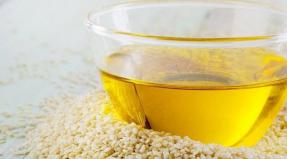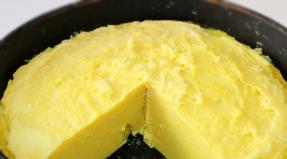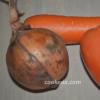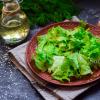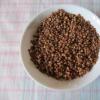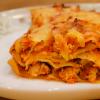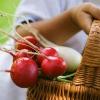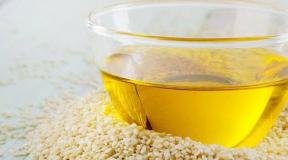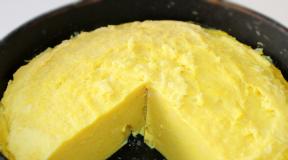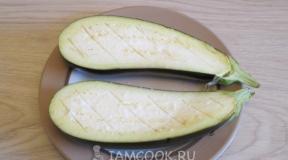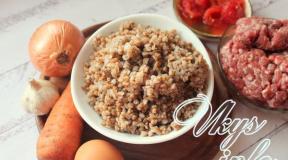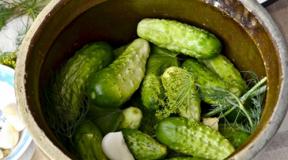Pickling cabbage. How to pickle cabbage at home - recipe
Preface
Pickling cabbage for the winter is a worthy and, most often, forced alternative to pickling it. Salted vegetables are no less tasty than pickled ones, but not as healthy. But preparing and storing them is much easier.
So, salt or ferment and what is the difference?
Of course, it's better to ferment. Vegetables turn out even healthier than fresh ones, but salted ones cannot boast of this. If you ferment for real, as this method of preparation should have been done before, that is, completely without salt, then:
- for the winter occurs due to fermentation only in its own juice. When salted, fermentation takes place in a salt solution.
- The preservative is natural lactic acid released from the product. During pickling, salt acts as the main preservative.
- During the fermentation process, vitamins, including ascorbic acid (vitamin C), and other beneficial components of the product are preserved. And salt partially destroys all this during the canning process, and primarily vitamin C.
- The fiber of the product softens, which means that when digested, it is much more fully, quickly and easily absorbed by the body. This does not happen when salting.
- The fermented preparation has a pure taste of the products included in it, with hints of the spices used. Salted vegetables have a predominant taste of salt.
Currently, there is no fundamental difference between fermentation and pickling, because salt is now used in both methods. As a result, during sourdough, as well as during salting, two components are preservatives - salt and lactic acid.
But still, the differences between these methods of canning remain the same, because salt is added during fermentation to the bare minimum - no more than 25 g per 1 kg of product. And when salted, it tastes and, as a rule, it turns out much more.
Why did they start adding salt when fermenting? Perhaps, first of all, to equalize the chances of fermented and salted products remaining tasty for a long time. Indeed, for the former, it is very important to maintain a certain storage temperature, otherwise they will quickly peroxidize or even deteriorate. And salt slows down the fermentation process and, together with lactic acid, suppresses the development of foreign microflora.
Why do many people prefer to salt?
From a practical point of view, pickling is more advantageous than fermentation. It only takes from one to several days to prepare salted cabbage, but until the pickled product reaches “standard”, you will have to wait several weeks or a month, or even more.

When pickled, cabbage also begins to ferment, but only at the very beginning of cooking. However, due to the large amount of salt, fermentation first slows down and then is almost completely suppressed. Lactic acid does not have time to be released in the same volume as during fermentation. Therefore, on the one hand, the cabbage turns out to be much less sour, and on the other hand, it will no longer ferment. This means it will last longer.
One more thing. It is better to ferment in an oak barrel or tub - the product will acquire an additional pleasant aroma and taste. When salting there is no need, and there is no point in these efforts. The process of ripening products goes quickly and therefore there is no time to pick up the oak aroma, and with the amount of salt it is almost impossible for vegetables. So you can salt it right away in jars.
Theoretical foundations of pickling cabbage
As mentioned above, the technology of pickling and fermentation is very similar. And we can assume that the only difference between them is the amount of salt. Even the pickling itself, not storage, is best done in a large container rather than in a jar. The finished product is transferred to the latter. In a large container it is more convenient to work with ingredients - mix, mash, remove foam if it appears due to fermentation in the first days, and so on - and the products are better salted.
So the question of how to pickle cabbage for the winter will not become a stumbling block for those who are already familiar with its pickling. It is enough to take any recipe for how to deliciously ferment this vegetable and you can use it for pickling, just add salt to taste - more or less. Selection and preparation of heads of cabbage for pickling, cutting them and other ingredients, additional products and spices, as well as utensils and even preparation methods are the same.
The difference begins when the brine becomes lighter in color and the foam stops forming. But when salting there is little or may not be there at all. Usually you need to keep the cabbage warm for the time specified in the recipe and test it for taste. After this, the sauerkraut continues to ferment - continue to cook, but in a cooler place and at the right temperature. And the salted one is already ready and it is packaged in jars and put away for storage.

It is best to salt white cabbage. Not only because it is more accessible and familiar to people of color and other foreigners. With the latter, few recipes make salted cabbage as tasty. Before salting, only the top and damaged leaves are removed from the heads of cabbage, small defects are cut out with a knife. All additional products are washed and cleaned.
When pickling, as well as during fermentation, vinegar is not used! Pickled foods are prepared with it. Use only non-iodized salt.
Jars for salted cabbage must be thoroughly washed and sterilized. They must be closed with lids that have undergone the same treatment. They can be made of polyethylene if the workpiece will be stored for no more than 3 months. Store salted cabbage in the refrigerator, cellar or similar cool, dark place.
Classic recipes for pickling cabbage - cook quickly and tasty
These are primarily recipes with only carrots, without adding other products. Such options are very simple and allow you to almost always prepare a very tasty dish. Below is one such salting method. You will need:
- heads of cabbage (large) – 1 piece;
- carrots (medium) – 3 pcs;
- salt – 5 tbsp. spoon;
- sugar – 1 tbsp. spoon.
Finely chop the head of cabbage into an enamel cup. Gradually add salt to the cabbage, knead it vigorously with your hands so that it releases its juice. Then grate carrots into a cup and add sugar. Mix everything thoroughly, and then, compacting it, put it in a jar. We place pressure on top, for example, a narrow bottle of water. Then place the jar of vegetables on a plate. If during fermentation the cabbage releases a lot of juice, it will drain into it. We leave the vegetables in a room where it is at room temperature. There they must be salted for three days.
After a day and in the following days, we remove the weight and pierce the workpiece with a Chinese wooden chopstick. We do this three times a day. Then we install the oppression in place. After three days, drain off the excess juice, close the container and put the cabbage away for storage.

Recipe with only beets and spices. You will need:
- heads of cabbage – 4 kg;
- beets – 0.4 kg;
- horseradish (roots) – 50 g;
- garlic (heads) – 1 pc.
For the brine:
- cloves (buds) and bay leaves - 4 pcs each;
- salt – 150 g;
- sugar – 100 g;
- water – 2 l.
We cut the heads of cabbage into large pieces, and the beets into small cubes. We grate the horseradish and crush the garlic with a press. Mix everything in a large container. Combine all the ingredients for the brine and bring the resulting mixture to a boil. Pour hot brine over the vegetables, load them with pressure and leave them to salt for two days. We put the finished product into jars.
Unusual recipes - salting cabbage with the addition of spices and other products
Salted cabbage, well prepared according to traditional recipes, is unlikely to get boring. But we want and need to add variety to the menu, and, therefore, to the preparation methods.
For lovers of spicy and Caucasian cuisine, we offer a recipe with hot pepper, cinnamon and other spices. You will need:
- cabbage (preferably small heads) – 2.5 kg;
- beets (small) – 1 piece;
- carrots – 0.2 kg;
- garlic (cloves) – 7 pcs;
- hot red pepper (pods) – 2 pcs;
- parsley and celery (roots) - 1 pc. each;
- cilantro (bunches) – 1 pc.
For the brine:
- black pepper (peas) – 10 pcs;
- salt – 160 g;
- cinnamon stick (small) – 1 pc;
- bay leaf – 2 pcs;
- water – 3 l.

First we prepare the brine. Bring the water to a boil and add all the ingredients for the brine. Reduce the heat to medium and mix everything thoroughly until the salt is completely dissolved. Boil the brine for about 3-5 minutes, then remove from the stove and set aside to cool.
Remove the top few leaves from the cabbage and set aside. Cut the heads of cabbage into 4 pieces. Chop the carrots into thin rounds. The beets should be cut into thin slices, and the pepper should be cut into 4 parts along the pod. It should be removed from the seeds if you do not want to make the cabbage very spicy. We also cut the roots lengthwise into 4 parts.
Place cabbage leaves on the bottom of a bucket or deep pan. Then we put the prepared vegetables there in layers: we alternate the cut heads of cabbage with a mixture of beets, carrots, spices, roots and herbs. Cover everything on top again with cabbage leaves. Then pour the cooled brine into the container with the workpiece. Place a lid or plate on the cabbage leaves, and place pressure on top of it. Leave the container for 5 days in a room at room temperature. During this time, the vegetables will be salted and they can be transferred to jars and stored.

Recipe with apples and cranberries. You will need:
- heads of cabbage – 2 kg;
- cranberries (can be frozen) – 150 g;
- medium apples and carrots - 3 pcs.
For the brine:
- garlic (heads) – 1 piece;
- salt – 3 tbsp. spoons;
- sugar – 250 g;
- water – 1 l.
First, if necessary, let the cranberries defrost. While the berries are warming up, prepare the brine. Heat the water to a boil and add salt, chopped garlic and sugar. Mix everything well, achieving complete dissolution of the bulk ingredients. Boil the brine for 2-3 minutes, then remove from the stove and set aside to cool.
We chop the heads of cabbage, grate the carrots, and cut the apples into thin slices. Then mix it all, and then put it tightly into jars, topping it with thawed or fresh cranberries. When placing in a container, the workpiece should be carefully compacted, being careful not to crush the berries. Then pour the cooled brine into the jars and leave them open for 3 days in a room at room temperature. Then the cabbage is covered with lids and hidden for storage.
Do you suddenly want to eat delicious salted cabbage? Have you decided to surprise your loved ones with a new appetizer? Do you like freshly salted, crispy cabbage? This means you need to read several recipes for quick pickling of cabbage, choose the one you like best, or several at once. And start cooking! How to salt cabbage in a quick way so that it is healthy, tasty and original? Take the necessary ingredients and start cooking right now. Let's look at a few recipes. Please note: a snack using vinegar is not recommended for people with gastrointestinal tract diseases, liver diseases, or following any diet. Try to combine taste and benefit, enjoy the snack, but not harm your health. There are great options without vinegar.
Only cabbageAn interesting recipe can be offered to lovers of a snack made from cabbage alone, without any additions. The flavors will not mix, you will be able to enjoy all the flavors of cabbage. You will need:
- 1 medium-sized head of cabbage;
- water – 1 liter;
- fine salt – 1 tablespoon;
- sugar – 1 tablespoon;
- a little dry dill (it is advisable to use whole “panicles” with seeds rather than dill powder).
- The cabbage must be carefully peeled from the top leaves, cut into several parts and the stalk removed. True, some connoisseurs of cabbage and the stump eat it with pleasure, but if you don’t usually eat it, you need to take into account that the stalk can give off an unwanted bitterness.
- Cut the cabbage into thin strips so that it resembles vermicelli. Cut some of the pieces, approximately 1/6 of the entire cabbage, into wider strips. As a result, you will end up with a kind of “cabbage platter”: pieces of different widths will differ in taste, wide slices crisp better and are a little less salty.
- After cutting all the cabbage, be sure to squeeze it with fine salt right on the table. The cabbage should begin to release juice. After this, immediately form a slide out of it and compact the mass a little.
- Place a few sprigs of dill in the jar, but not too many, otherwise the brine will become bitter. Two or three medium branches are enough.
- Boil water with salt.
- Place all your cabbage in the jar, but do not pack it too tightly, otherwise the brine will not soak it well.
- Pour boiling brine over the cabbage.
- Close the jar with a regular plastic lid and leave for 3-5 hours. It all depends on your preferences. If you want to get very soft cabbage, as after long-term pickling, you can wait 6 hours. But if you like a little crispier, denser and juicier cabbage, it’s enough to keep the jar for only 3 hours.
Advice
First, try some kale from a jar. If it seems to you that this is not what you need yet, just leave the jar for some more time. The taste and consistency will change gradually. By checking the doneness every half hour or so, you can easily determine the optimal time for the cabbage to become the way you like it. Write it down so that you can always add exactly this amount of cabbage.
Recipes for quick cooking of salted cabbage
To quickly salt cabbage, just add a little more salt and pour boiling brine over the cabbage. You can also use vinegar, then your cabbage will become not only salty, but also pickled. In any of the recipes you can remove the vinegar, but keep in mind that you will need about 1/3 more salt.
Cabbage with carrots
You will need:
- cabbage – 1 head;
- liter of water;
- vinegar – 1 tablespoon;
- sugar – 1 tablespoon;
- coarse salt – 2 tablespoons;
- approximately 1 spoon of vegetable oil;
- saffron;
- fine salt;
- dill;
- one medium sized carrot.
- Cut the head of cabbage into several large pieces. Remove the stalk.
- Peel the carrots, grate them on a coarse grater or cut them into strips.
- Prepare your brine using vinegar, sugar, salt, oil and water.
- Place some dill and saffron at the bottom of the jar for flavor.
- Chop the cabbage finely.
- Squeeze the cabbage and salt it a little with fine salt.
- Mix cabbage with carrots and squeeze again.
- Boil the brine.
- Fill the jar with your carrots and cabbage.
- Pour boiling brine over vegetables.
- Leave the cabbage to salt for 4-6 hours.
White and red cabbage with beets
Take the following ingredients:
- two heads of cabbage - white and red;
- two medium-sized beets;
- three small carrots;
- two liters of water;
- 4 tablespoons of coarse salt;
- 2 cloves of garlic;
- vinegar - 1.5 tablespoons;
- fine salt;
- 2 spoons of sugar;
- dill;
- black currant leaves;
- 2 tablespoons of vegetable oil.
- Cut the cabbage heads and remove the stalks.
- Divide the pieces of both heads of cabbage into two equal parts.
- Shred half of the available cabbage finely so that it resembles thin noodles, and the other half a little larger. This way the taste will become richer and more original, as if you were using four types of cabbage rather than two.
- Lightly squeeze the cabbage along with the carrots and add fine salt.
- Beets and carrots must first be peeled and then chopped or grated on a coarse grater. An appetizer where some of the vegetables are chopped and some are grated will look unusual.
- Crush the garlic or grate it on a fine grater.
- Place dill and currant leaves on the bottom of the jar.
- Prepare a brine from oil, vinegar, salt, sugar.
- Place one layer of cabbage with carrots in a saucepan, layer with beets and garlic, then cover the beets with a second layer of cabbage and carrots.
- Boil the brine in another pan and pour it over your cabbage. Cover the top of the mass with a circle, a plate, and press down with a weight. It is advisable to ensure that the mass is well compressed.
- After 1.5 hours, transfer the mixture to a jar. Leave for another 3-5 hours.
Garlic in cabbage can be put in small whole cloves, cut into small cubes. You can salt cabbage and beets, but do not add carrots or garlic. Saffron will make the taste more refined. It’s good to add peppercorns and bay leaves to salted cabbage. The main thing is not to overdo it, otherwise bitterness will appear. 2-4 peas of pepper are enough, and one small leaf of bay leaf is enough. Bon appetit!
Pickling cabbage is a somewhat lengthy process, and even the fastest option will take you at least a day. For pickling, winter varieties of white cabbage are used mainly. To improve the taste and nutritional value of the dish, carrots are used, which also gives the snack a more attractive appearance. Depending on the recipe, apples, cranberries, lingonberries, sweet peppers, caraway seeds, dill, bay leaves and other spices are added.

Many people do not see a significant difference between pickling and pickling cabbage. These processes are really similar. The difference is that when salting, a larger amount of salt is used and the cooking process takes a maximum of several days. Whereas for the cabbage to be fully fermented, more than one week must pass. But excess salt does not affect the taste of the snack in any way - the cabbage turns out just as crispy, with a pleasant sweet and sour taste.
It is believed that salted cabbage retains a large amount of vitamins and other substances necessary for the body.. It also contains potassium, which helps normalize blood pressure and strengthen the muscles of the heart and nerve cells. In winter, it is difficult to find a more affordable product high in vitamin C than salted cabbage. In this regard, only lemons and oranges can compete with it.
Secrets of making perfect pickled cabbage
Pickled cabbage is not only an excellent snack, but also an excellent source of vitamins and nutrients that the body lacks in winter. However, you can eat it at any time of the year, it is tasty and crispy - it will not leave anyone indifferent in summer, autumn, and spring. About, how to deliciously pickle cabbage, experienced chefs will tell you:
 Secret No. 1. If you need to cook cabbage as quickly as possible, pour hot brine over it. High temperature will speed up the fermentation and salting process, and the dish will be ready in just a few hours.
Secret No. 1. If you need to cook cabbage as quickly as possible, pour hot brine over it. High temperature will speed up the fermentation and salting process, and the dish will be ready in just a few hours.
 Secret No. 2. The cabbage can be cut as desired; it does not have to be finely chopped. A tasty appetizer is made from cabbage cut into large pieces, such as squares.
Secret No. 2. The cabbage can be cut as desired; it does not have to be finely chopped. A tasty appetizer is made from cabbage cut into large pieces, such as squares.
 Secret No. 3. It is very good to add horseradish roots when pickling cabbage. This is necessary so that the finished cabbage has a pleasant crunch and is not soft.
Secret No. 3. It is very good to add horseradish roots when pickling cabbage. This is necessary so that the finished cabbage has a pleasant crunch and is not soft.
 Secret No. 4. For quality cooking of cabbage, choose coarsely ground rock salt. Iodized salt is completely unsuitable for pickling.
Secret No. 4. For quality cooking of cabbage, choose coarsely ground rock salt. Iodized salt is completely unsuitable for pickling.
 Secret No. 5. Make sure that the brine completely covers the cabbage during the fermentation process. If this does not happen, then increase the mass of the load (for example, place a larger jar).
Secret No. 5. Make sure that the brine completely covers the cabbage during the fermentation process. If this does not happen, then increase the mass of the load (for example, place a larger jar).
 Secret No. 6. To pickle cabbage, you should choose tight heads of late varieties. The early ones contain little sugar and have loose heads, so the cabbage turns out to be of poor quality. Make sure that the vegetable is not damaged. It is better to remove the top leaves of cabbage; they are usually limp with a greenish tint.
Secret No. 6. To pickle cabbage, you should choose tight heads of late varieties. The early ones contain little sugar and have loose heads, so the cabbage turns out to be of poor quality. Make sure that the vegetable is not damaged. It is better to remove the top leaves of cabbage; they are usually limp with a greenish tint.
 Secret No. 7. Cabbage can be chopped with a regular kitchen knife, but it is more convenient to use special shredders or graters, vegetable cutters, or chop the vegetable in a food processor.
Secret No. 7. Cabbage can be chopped with a regular kitchen knife, but it is more convenient to use special shredders or graters, vegetable cutters, or chop the vegetable in a food processor.

A simple and quick way to prepare cabbage; the appetizer will be ready within a day. And the very next day after salting it can be served. If you are not in a hurry, then leave the cabbage in the brine for 2-3 days, so it will acquire a richer taste and aroma.
Ingredients:
- white cabbage - 1 kg;
- water - 500 ml;
- carrots - 1 pc.;
- table vinegar - 1 tbsp. (9%);
- vegetable oil - 1 tbsp.;
- salt - 4 tbsp. l.;
- bay leaf - 10 pcs.;
- dry dill seeds - 1 tsp;
- cloves - 2 pcs.;
- black pepper - 10 peas.
Cooking method:
- Wash the cabbage and chop finely.
- Peel the carrots and grate them.
- Mix the vegetables in an enamel container, add bay leaf, pepper, and dill seeds.
- Let's prepare the brine. In a saucepan, boil water with the addition of salt, sugar, cloves, vinegar and oil.
- Pour the prepared brine over the cabbage and mix everything well. Close the container with a lid and leave for a day at room temperature.
- The next day, put the cabbage in jars and place in the refrigerator or serve immediately as a snack.
Interesting from the network

This cabbage has a wide range of uses. It can be served as an independent dish, seasoned with vegetable oil. Or cook fragrant pies and pies, cook cabbage soup, stew meat and potatoes. The cabbage itself turns out incredibly tasty, and the beets give the appetizer a beautiful bright burgundy hue. For pickling, it is best to choose a strong, dense head of cabbage weighing 3-4 kg.
Ingredients:
- cabbage - 4 kg;
- beets - 400 g;
- garlic - 1 head;
- horseradish roots - 50 g.
- water - 2 l;
- sugar - ½ tbsp.;
- salt - 100 g;
- cloves - 4 pcs.;
- black pepper - 10 peas;
- bay leaf - 4 pcs.
Cooking method:
- Wash the cabbage, separate the top leaves and cut into large pieces.
- Peel the beets, wash them, cut them into small cubes.
- Peel the horseradish roots and grate them.
- Press the peeled garlic through a press.
- Mix all ingredients in a large container.
- To prepare the brine, pour water into the pan, add all the spices, and bring the liquid to a boil.
- Pour the resulting hot brine over the vegetable ingredients. Cover the container with a lid of a smaller diameter and place pressure on top, for example, a three-liter jar of water.
- Place the cabbage and beets in a cool, dark place for pickling and fermentation. After two days, the snack can be transferred to glass containers, closed with lids and stored in the refrigerator.

Delicious crispy cabbage with a pronounced spicy aroma - this snack will delight you in the cold winter. For pickling, it is best to use small-sized cabbage; the ideal option is white winter cabbage. Before storing food, jars should be prepared; it is not necessary to sterilize them; just rinse them thoroughly and dry them. According to this recipe, the cabbage is finely chopped; for this it is rational to use a special vegetable shredder. The amount of carrots depends on your personal preferences; 2-3 root vegetables are enough for one jar.
Ingredients:
- cabbage - 1 large head;
- carrots - 2 pcs.;
- sugar - 1 tbsp. l.;
- salt - to taste.
Cooking method:
- Wash the cabbage, remove the top leaves and finely chop.
- Place the chopped ingredient in an enamel bowl.
- To release the juice, knead the cabbage vigorously with your hands (like dough). At the same time, add salt little by little. As a result, the cabbage should turn out a little saltier than necessary.
- To speed up the fermentation process, add sugar.
- Peel the carrots, grate them, mix with cabbage.
- Place the vegetables in a jar, compacting the ingredients. You need to put pressure on top. This can be an ordinary nylon lid, which we press well into the jar, compacting the cabbage.
- We place the jar of cabbage on a plate, since during the fermentation process gases will form and the juice may spill out of the jar.
- Leave for 3 days at room temperature. After a day, we remove the press and pierce the cabbage to the bottom with a long knife so that the resulting gas escapes. We do this 2-3 times a day. Each time we put the press back.
- After 3 days, remove the press, drain the juice, close the jar with a lid, and put it in the refrigerator for storage.

Cabbage pickled according to this recipe will be ready in just a few hours. You can use frozen cranberries, but you just need to defrost them first. In addition to these ingredients, you can add pieces of sweet pepper, spices and spices to the dish. Serve the finished cabbage as a snack. It’s good to add a little vegetable oil, such as olive oil, and chopped onion into rings.
Ingredients:
- cabbage - 2 kg;
- carrots - 3 pcs.;
- apple - 3 pcs.;
- cranberries - 150 g.
- water - 1 l;
- salt - 2 tbsp. l.;
- vegetable oil - 1 tbsp.;
- sugar - 250 g;
- table vinegar - ¾ tbsp.;
- garlic - 1 head.
Cooking method:
- Wash the cabbage and chop it.
- Peel the carrots, wash them, grate them.
- Cut the apples into large slices.
- Let's prepare the brine. Pour water into the pan, add salt, sugar, vinegar, oil, peeled and chopped garlic. Bring the liquid to a boil.
- We place the components in enamel dishes in layers. First cabbage, carrots, then apples and cranberries, then cabbage again and repeat the layers. Fill the ingredients arranged in this way with brine. We install oppression on top.
- The cabbage will be ready in a few hours, a maximum of a day.
- When serving, add a little butter and onion, cut into rings.
Now you know how to prepare pickled cabbage according to a recipe with a photo. Bon appetit!
Cabbage cannot always be kept fresh for long winter months, so it is customary to salt, pickle it and prepare winter salads from it. For pickled cabbage, various types of acid are added to the mixture, and this is not always healthy. The best option would be to pickle cabbage in jars for the winter. Here are the best homemade recipes for pickling cabbage, and on the website you will find cooking options and.

Cabbage goes well with carrots, and carrots not only add flavor to the preparation, but also give it a more beautiful color. Pepper and bay leaves add a pleasant green aroma. This preparation can be safely served on a festive table; it is beautiful and perfect as an appetizer before main courses.
Required ingredients:
- Cabbage – 2.5-3 kg;
- Fresh carrots - 2 medium pieces;
- Coarse salt - 2 tbsp. l.;
- Granulated sugar - 1 incomplete tbsp. l.;
- Laurel – 3-5 leaves;
- Black pepper – 3-5 peas;
- Water – 1 liter.
How to pickle cabbage at home - recipe:
- First you need to prepare a brine in which the vegetables will be salted. To do this, you need to boil water, add salt and sugar to the water, keep it on the stove for another 2-3 minutes, then you can remove it from the stove and leave it to cool thoroughly;
- While the liquid is cooling, you can begin preparing the vegetables. Wash the cabbage, cut into several pieces, remove the hard stalk, cut off the thick veins from the leaves, and cut the pulp itself into thin strips. You can use special knives or shredders;
- Wash the carrots, peel, cut into thin long strips, similar to Korean carrots;
- Mix the vegetables, mash them a little with your hands so that they release juice;
- Fill pre-prepared jars with prepared vegetables, periodically adding pepper and bay leaves to them;
- After this, the pulp is poured with prepared brine, then covered with lids and left in the room for 3-4 days. Periodically, the pulp needs to be pierced with a long stick;
- Now you can close the jars with lids and store them in a cool place.
How to pickle cabbage with beets

Other vegetables are often added to cabbage. They allow you to get a more tasty and aromatic mixture. The beets complement the flavor and give the cabbage an amazing color, as salted cabbage has a pale hue. This recipe uses not only coarse salt and granulated sugar, but also aromatic bay leaves, spicy black pepper, cloves, and horseradish, which makes the mixture more appetizing.
Required ingredients:
- White cabbage – 4 kg;
- Beets - 2-3 medium fruits;
- Garlic – 1 head;
- Horseradish – 1-2 roots;
- Salt – 100 grams;
- Sugar – ½ cup;
- Bay leaf – 4 pieces;
- Carnation - 2 umbrellas;
- Black pepper – 8-10 peas.
How to salt cabbage in brine:
- First, the brine is prepared, for it you need to bring clean water to a boil, add the necessary salt, sugar, bay, black pepper, cloves, put aside to cool;
- While the brine is cooling, you need to prepare the vegetables, wash the cabbage, cut out the hard stalk and rough veins, cut into arbitrary pieces, you can cut the vegetables into thin strips, it doesn’t really matter;
- Peel the beets and cut into small cubes;
- Peel the horseradish and garlic, finely chop it on a grater or through a meat grinder;
- Mash the cabbage slightly to release the juice, mix with garlic and horseradish;
- Place the pulp in a jar, periodically adding beet cubes;
- Cover the jar with a lid and put pressure on it, the mixture should be salted for about 2-3 days, during this period it is necessary to periodically stir the mixture;
- After this, the workpiece can be closed and placed in a permanent storage location.
How to quickly pickle cabbage

In the fall, the harvesting season begins; the housewife can stand at the stove for hours and make preparations for the winter. But a simple recipe for pickling cabbage for the winter will not require a lot of time from the housewife. The most important thing is to chop the pulp, but for this you can use a food processor and a special shredder. The preparation is easy to prepare and the taste is very good. You can add carrots to the mixture, but this is not at all necessary; the mixture turns out tasty without carrots.
Required ingredients:
- Fresh cabbage – 20 kilograms;
- Carrots – 600 grams;
- Salt – 400 grams.
How to pickle cabbage in a jar:
- Wash the cabbage, remove the stalk, immediately chop it using any method, you can chop it into small strips, or you can chop it into fairly large pieces, in any case, the pulp will be well salted and remain crispy;
- Wash the carrots, peel them and grate them on a fine grater; you can also put them through a shredder;
- Add a measured amount of salt to the prepared vegetables, mix well, place in a container for pickling (these can be glass jars, tanks, stainless steel basins, etc.), cover and apply pressure;
- Store the mixture in a cool room or refrigerator for 3-4 days;
- Then you can put it away for permanent storage.
How to salt cabbage for the winter in jars with pepper and garlic

Cabbage prepared according to this recipe does not require long preparation, and it can be stored throughout the winter months. Pepper and garlic added to the recipe will make the preparation piquant and interesting in taste. You can adjust the spiciness yourself and, if necessary, increase or decrease the amount of spices. Salted cabbage in jars for the winter is a storehouse of vitamins.
Required ingredients:
- Cabbage – 3-5 kilograms;
- Carrots – 1 medium piece;
- Hot pepper in a pod – 1-2 pods;
- Garlic – 3-5 cloves;
- Salt – 20-50 grams.
How to salt cabbage in jars for the winter:
- Wash the vegetables, peel them, chop them into thin strips, conveniently chop them using a special shredder in a food processor, in this case you get the perfect thin strips;
- First cut the capsicum in half, then remove the seeds, you can take two pods and then the workpiece will turn out spicy;
- Peel and finely chop the garlic; you can cut it into thin slices;
- Mix all the vegetables, transfer to a suitable container, add salt, the amount can be changed based on the desired taste of the final product;
- The pulp must be mashed with your hands until the vegetables release a lot of juice;
- Put pressure on the mixture and stir periodically for three days, after which you need to try the mixture, if the taste is good, then you can transfer the mixture into jars and store it, and if the mixture is not completely salted, then you can leave it for another 1-2 days .
Recipe for pickling cabbage in jars with apples

Apples, for this recipe, as for, it is better to choose late green varieties, they have sourness and go well with vegetables. In addition to the fruits, this recipe only needs coarse salt and water. You can prepare a large number of pickles in one preparation. All components do not lose their beneficial properties during this preparation and remain crispy. This simple recipe for pickling cabbage will not take much time.
Required ingredients:
- Fresh cabbage of late varieties – 10 kg;
- Apples – 0.5 kilograms;
- Carrots – 500 grams;
- Coarse salt – 250 grams.
- Wash the cabbage, separate it into separate leaves, remove the stalk, cut off the rough parts, then chop into small strips;
- Peel the carrots, it is most convenient to grate them, you can use large or small ones, the main thing is that the pieces are not too thick;
- Wash the apples, remove the core, and then cut into thin slices;
- Combine all the fruits and mix well;
- Now you need to quickly cook the brine; to do this, you need to bring water to a boil, dissolve a measured amount of salt in it;
- The jars are prepared in advance, they can simply be washed, but the workpiece is subsequently stored in a cold room, or the jars can be sterilized, then they can be stored at room temperature;
- Fill the jars with pulp, compacting well;
- Fill the jars with warm brine, roll up with iron lids and turn over until completely cool;
- The preparation will be ready in a week and you can already try it, and you can store it throughout the winter.
How to pickle cabbage so it's crispy

Dill added to cabbage gives the preparation color, taste and, of course, the aroma of fresh herbs. This combination contains a large amount of vitamins that can be obtained throughout the winter months, and we really need them in winter. In this case, the apples are not cut, but remain whole. Therefore, this recipe allows you to quickly salt cabbage in a jar, as well as apples.
Required ingredients:
- White cabbage – 3 kilograms;
- Apples – 1.5 kilograms;
- Carrots – 200 grams;
- Salt – 3 tbsp. spoons;
- Granulated sugar – 2-3 incomplete tablespoons;
- Dill seeds - 3 tbsp. l.;
- Water – 2.5-3 liters.
Step-by-step cooking instructions:
- Wash the cabbage, cut out the stalk, cut into slices or thin strips;
- Wash the apples, select spoiled ones, use only good fruits,
- Wash the carrots, peel the skin, grate;
- Now is the time to prepare the brine; to prepare it, add sugar and salt to cold water, stir until the crystals dissolve;
- In a container, mix the pulp of cabbage, chopped carrots and dill seeds;
- Place the pulp in a container, compact it well, pour in 0.5 liters of brine, lay the apples tightly in one layer, then put some of the pulp again, fill with brine, then again a layer of apples and a final layer of pulp, compact everything properly again, pour in the remaining brine, put a plate on top and press down so that the brine comes to the surface;
- The workpiece must be kept under pressure for about a week, then the mixture can be put into jars and sent to a permanent storage place.
Salted cabbage may be too salty, but before eating, you can rinse it under running water to remove excess salt. Late varieties of cabbage are used for pickling; in this case, it will turn out crispy and tasty.
